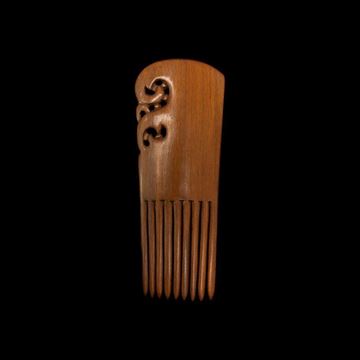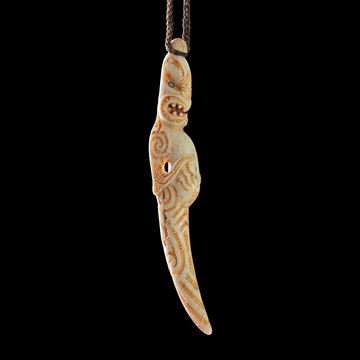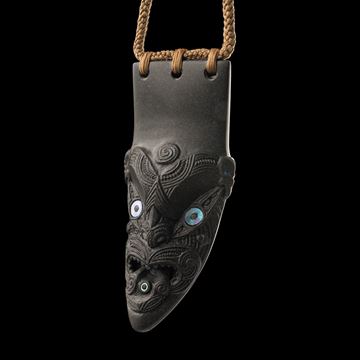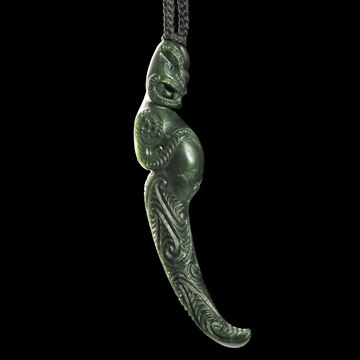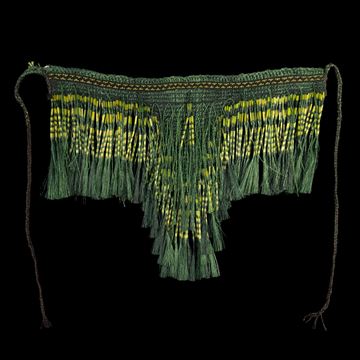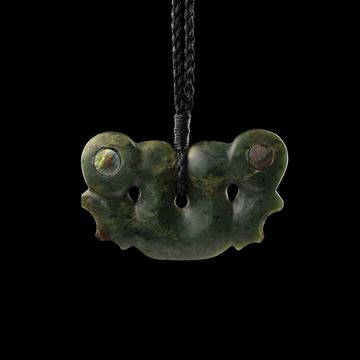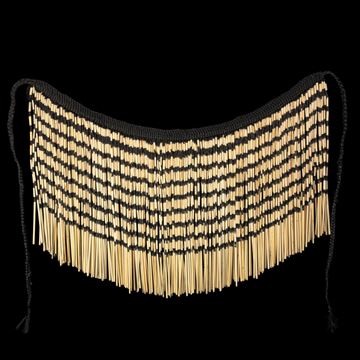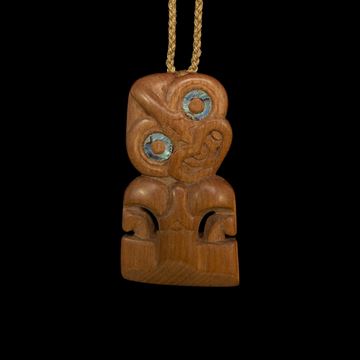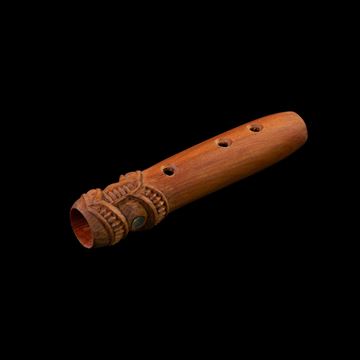
Āhua Gallery
Select Subcategory
Heru - 4958CF
Heru were produced in varying shapes and sizes and were made from rākau (wood) and in some instance’s parāoa (whalebone). These combs were highly valued as personal heirlooms and were consequently passed down from one generation to the next, often acquiring their own personal names.
The combs were mostly decorative and held the pūtikitiki (top knot) in place. When a comb was broken, it was placed in a swamp or a sacred place for safe keeping because the head was the most sacred part of the body and therefore tapu (sacred).
Material: Tōtara
Measurements: 230mm x 90mm x 4mm
$2,100.00
Aurei - 5474MA
Aurei were customarily used as a pin for fastening cloaks and may be made from bone, stone, wood or shell. They may also have been worn through the ear as an earring or around the neck as a pendant. Aurei are still commonly worn as pendants and earrings and as with most Māori personal adornments, are often passed down generationally.
Material: Parāoa (Whalebone)
Measurements: 142mm x 15mm x 23mm
$1,900.00
Rei Puta - 3885HW
The mark of a high Chief was one who wore the Rei Puta (whale tooth pendant), as the teeth of the Sperm Whale were highly prized because of their rarity. With actual whale teeth being such a rarity, it became common to fashion the tooth form from other materials.
Material: Onewa (NZ Greywacke)
Measurements: 135mm x 63mm x 30mm
$1,850.00
Aurei - 5473MA
Aurei were customarily used as a pin for fastening cloaks and may be made from bone, stone, wood or shell. They may also have been worn through the ear as an earring or around the neck as a pendant. Aurei are still commonly worn as pendants and earrings and as with most Māori personal adornments, are often passed down generationally.
Material: Pounamu (Kawakawa)
Measurements: 135mm x 28mm x 17mm
$1,800.00
Maro - 4905TE
The maro is a frontal apron tied around the waist and is a traditional garment that is worn by both men and woman. This maro has been fashioned with strands of muka fibre within the flax.
Material: Harakeke & Muka
Measurements: 680mm x 480mm
$1,395.00
Aurei Koruru - 5441KH
Aurei were customarily used as a pin for fastening cloaks and may be made from bone, stone, wood or shell. They may also have been worn through the ear as an earring or around the neck as a pendant. Aurei are still commonly worn as pendants and earrings and as with most Māori personal adornments, are often passed down generationally.
Material: Koiwi (Beef Bone)
Measurements: 124mm x 18mm x 10mm
$1,250.00
Pekapeka - 5694RH
The Pekapeka (native NZ bat) represents the interwoven nature of the spirit world and the world of the living – the seen and the unseen. The bat was interpreted by Māori as a creature who symbolically acted as an interface between the two worlds and whose physiology (which does not possess the gift of sight) appeared to be guided by the ethereal and the metaphysical.
Material: Pounamu (Kawakawa)
Measurements: 60mm x 35mm x 8mm
$1,100.00
Piupiu (Tāne) - 5954AF
The word 'piupiu' means 'to swing’ and is also the name for a skirt with free-hanging strands. Piupiu can be worn either around the waist or across one shoulder. They were made in many types of material and styles.
Material: Harakeke
Measurements: 32.5 inches
$1,090.00
Tāniko Belt - 2726TE
Tāniko weaving produces a relatively stiff and unyielding fabric, it was traditionally used as a decorative border on fine cloaks of the kaitaka and paepaeroa types. Often several different strips of tāniko appeared on up to three sides of a cloak.
Material: Acrylic Cotton, Leather Lining, Macrame Silks
Measurements: 1150mm x 40mm
$990.00
Hei Tiki - 3147UN
Hei tiki are the best known of all Māori adornments. Tiki are symbols of fertility that depict a new-born child. They are often family heirlooms bearing personal names and embodying their wearers lineage. As with most Māori personal adornments, hei tiki are often passed down generationally.
Material: Rātā
Measurements: 134mm x 70mm x 20mm
$890.00
Hei Tiki - 3148UN
Hei tiki are the best known of all Māori adornments. Tiki are symbols of fertility that depict a new-born child. They are often family heirlooms bearing personal names and embodying their wearers lineage. As with most Māori personal adornments, hei tiki are often passed down generationally.
Material: Rātā
Measurements: 115mm x 64mm x 20mm
$890.00
Kōauau 5859HY
Kōauau are part of the flute family and come to us from the atua (spiritual entity) of flute music Hine Raukatauri. Kōauau is also the name for a species of hollow kelp, which can also be used to make instruments. Kōauau are made from a variety of different materials including wood, bone or sometimes stone. Most Kōauau have 3 wenewene (finger holes) although there are several older examples that have 4 or more. The kaiwhakangāwari is the wenewene closest to the mouth, the kaiwhakahī is the middle wenewene and the kaiwhakakaha is the wenewene closest to the distal end.
There are many uses for kōauau. In Māori tradition, birds are sometimes seen as important messengers from the spirit world. Kōauau have a reputation of attracting the native birds of Aotearoa. The birds will often interact with the beautiful melody from the kōauau, giving us a glimpse of the spiritual aspects of the kōauau song.
Material: Mataī (NZ Native)
Measurements: 123mm x 26mm x 26mm
$850.00

